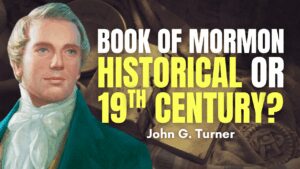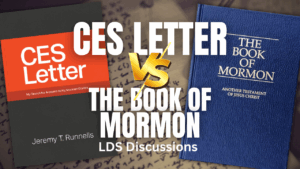In this short Mormon Stories Episode I sat down with Trent Told, who created a prototype of Joseph Smith’s Book of Mormon Plates. Based on Dan Vogel’s theories surrounding the “Tin Plates” and the Book of Mormon, Trent created a proof of concept model of the Book of Mormon made out of tin, in order to help demonstrate the physical size and weight of the plates. This model is also intended to help illustrate complexity and improbability that Joesph Smith could have possessed and handled actual Gold Plates (let alone run with them).




4 Responses
Excellent episode. Like Mr. Told, I too attempted a mock-up of the golden plates using tin snips and various metal sheets, which in my case was brass, copper, and even gold-anodized aluminum plate, which I then attempted to etch, both by hand and by laser-engraving. I followed the rough dimensions claimed by the various sources and my mock-ups all came in between 35 and 50 lbs. Likewise, the perceived weight of my plates was always guessed to be higher than the real weight by strangers who I asked to heft them. I also came to the conclusion that Mr. Told expressed, that the “sealed portion” (2/3rds of the stack) was probably sealed because of the difficulty of etching small characters on the plates and Joseph simply got tired of carving squiggles on his plates but he needed more of them to constitute enough text to equal his American “bible”. Thus they were “sealed” to prevent anyone from seeing that they were actually blank.
How could they have been sealed? With a simple brass foil, soldered shut with common solder and a brazing iron, into an envelope form around a stack of blank plates. Brass foil, also available on the frontier, is simply a thinner gauge of brass than brass sheet, so thin that it wrinkles and bends easily by hand. Of course, brass was more expensive than either tin (the cheapest) or copper (somewhat cheaper), but it was still available and it has the advantage of being more “gold-like” in appearance. I don’t rule out the possibility of Smith’s plates being a hybrid construction of cheap tin inside the brass envelope for the 2/3rds sealed portion and perhaps more expensive brass or copper for the 1/3 that were exposed and etched. This brings me to the task of how do we make copper, tin or even brass plates more “golden” in appearance.
All these metals tarnish quickly in the elements, but brass is the best candidate for making a “golden bible” look golden because it doesn’t have to be covered quite so much with gold paint or gold leaf (both of which contain real gold). I favor some sort of gold paint, which then would be “aged” with lamp black to make it not so new looking in appearance. The trouble with either gold paint or gold leaf is that objects covered in them are NOT meant to be handled. They will scratch or tarnish easily and therefore if Smith used them as show pieces (possibly with the Eight Witnesses) he would have wanted to limit their handling to the bare minimum. Which it appears he did. With none of these materials and methods does one’s prop withstand serious scrutiny, therefore the prop had to be disposed of asap. Hence the disappearing plates was necessary.
I note that while Dan Vogel does believe a set of prop tin plates was made by Smith to fool his family while they were hidden in a bag or a box, he does NOT believe that this tin prop was shown to the 3 or the 8 Witnesses. Mr. Vogel feels that those visions were entirely spiritual. He also feels that there was no physical “sealed portion” of the plates, that this “sealed” portion was merely a misinterpretation of early metaphorical descriptions of the BoM’s contents. (And, of course, why would you seal a portion of something that was never meant to be seen?) On the other hand, as Mr. Told has sussed out, you would very much want to seal 2/3rds of your prop if you’ve grown sick to death of etching tiny squiggles over the remaining third. And I have a problem with Mr. Vogel’s theory that Smith crafted a prop only to hide it in a bag to fool his family, and then never to show it to anyone. I don’t think counterfeiters make fakes with no intention of ever showing them. Every counterfeiter tries to make the best fake he can. With that said, I think Smith got in over his head while crafting his fake and he realized that no matter how he painted it and artificially aged it and hid the tin inside a sealed portion, he was never going to fool experts who got a good long look at it. Thus he had to be careful with it and it had to be taken back into heaven as soon as it had served it’s purpose. Look what happened to the Voree Plates and Kinderhook Plates and Cardiff Giant when they were allowed to sit around in embarrassing existence after the fact.
Weren’t there brass plates too? I thought the plates they took from Laban were brass, no? How does the weight of brass compare to tin & gold?
I have done what I would consider physically impossible things which made me realize that—“cool! God in this moment performed a miracle“. Unbelief along our mortal probationary period way and dark entities (Satan and his hosts) has us put our faith in a tight box which prevents us receiving important witnesses of God’s amazing reality.
Excellent episode. But the problem isn’t proving that a pile of plates can be recreated even if we knew the exact metal composition of the plates. The real question is
how thin can one make any metal plates and still be able to “engrave” glyphs on them without cutting through the plate.
But, most importantly is to determine how many glyphs were on the original plates per page.
The ideal experiment would be to have an Egyptologist translate about 6 pages of the modern book of Mormon into hieroglyphs of the period between 600 BCE and 400 BCE. Then have an engraver try to engrave those glyphs on a copper or brass plate and determine the minimum thickness necessary to avoid tearing the plate. Then and most importantly, count the number of glyphs possible per plate.
The solution is in the number of glyphs per plate; the Fraud of Mormonism has been proven by the word count: consult “see no god, speak no god, hear no god” Youtube channel connected to the Atheist University
Keep up the good work.